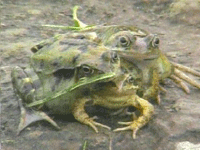Problems with solutions
In March a 3-headed, 6-legged frog hopped into a nursery school garden. The children were fascinated. If they had been older, they might have speculated that radioactivity or toxic (teratogenic) chemicals polluting the frog’s pond had caused the abnormality. Had science fiction come true? Or is there a less-frightening explanation? The frog escaped, so we may never know. What is certain however, is that solutions of certain pollutants in our water courses can cause serious problems and must be monitored.
Have you ever wondered how pollution levels are monitored?
You might like to …
• research a local river or lake to decide what pollutants are most likely to be dissolved in it, and what problems they might cause; this will depend on the type of area (town or country), and what sort of wastes flow into it (for example, agricultural, industrial, power station, sewage, etc.)
• decide methods of collecting samples; think how you will ensure that the samples are representative of the body of water (warning: never go sampling on your own; you must be supervised)
• use water test kits and other methods to analyse samples for the most likely pollutants; compare samples from upstream and downstream of any waste discharge point or outfall
• check water temperatures above and below an industrial site that uses the water for cooling (remember: heat can be a pollutant; explain why)
• arrange a visit to an industrial site, to see how discharges are minimised, and how they are monitored.
Further links:
Have you ever wondered how pollution levels are monitored?
You might like to …
• research a local river or lake to decide what pollutants are most likely to be dissolved in it, and what problems they might cause; this will depend on the type of area (town or country), and what sort of wastes flow into it (for example, agricultural, industrial, power station, sewage, etc.)
• decide methods of collecting samples; think how you will ensure that the samples are representative of the body of water (warning: never go sampling on your own; you must be supervised)
• use water test kits and other methods to analyse samples for the most likely pollutants; compare samples from upstream and downstream of any waste discharge point or outfall
• check water temperatures above and below an industrial site that uses the water for cooling (remember: heat can be a pollutant; explain why)
• arrange a visit to an industrial site, to see how discharges are minimised, and how they are monitored.
Further links:


